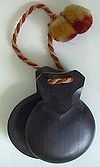- Muiñeira
-
Muiñeira is traditional dance and genre musical genre typical to Galego which is known as Galacia. It is distinguished mainly by the tempo of 6/8, played expressive and lively, although some variants are performed in other time signatures. There are also variant types of muiñeira which remain in the tempo of 6/8 but which displace the accent in different ways.[citation needed] Muiñeira is associated with traditional choreographic schemes and the associated instrumentation is a form of bagpipe known as a gaita. It is subject to highly varied interpretation in differering local traditions. According to "Galicia-The Spanish Cousins", an article on Roots World,[1] muiñeira is the Galician "equivalent" of a jig, which is consistent with the time signature of 6/8 [2]
Contents
Galicia
Main article: Galicia (Spain)The Galicians are an ethnic group, a nationality whose historical homeland is Galicia in north-western Spain. Most Galicians are bilingual, speaking both their historic language, Galician, and Castilian Spanish. Their music is classified as part of the body of Celtic music.
Characteristics of muiñeira dance
It is a dances of playful character and with a social component expressing historic social culture of gallantry. It is somewhat more permissive of improvisation than other folk dances, improvised in seráns and fiestas, and exhibitions. Some interpreters[citation needed] have added increasing complexity to its choreography.
It is played at a fast tempo. Dancers often form a circle or parallel threes. Often jumps are incorporated, synchronized with percussion accompaniment. snare-drum known as tamboril (a wooden natural-skinned drum with gut snares), and the bombo, a bass drum.
Videographic documentation
Examples and exemplary proponents
Examples of the genre recommended by native Spanish commentators [4] include ' ' Muiñeira de Chantada' ' and to ' ' Muiñeira de Lugo' '.
Carlos Nuñez
According to RootsWorld, which claims to be the first music magazine published on the web,[5]"the most prominent gaita virtuoso in Galicia, and one of the world's best, is Carlos Nuñez. He often tours and records with the Chieftains, who consider him an auxiliary member of the group". Nunez performed a "Muneira de Chantada" with the Chieftains in early 2008, which featured Irish foot dancing.[6]</ref>
Susana Seivane
Susana Seivane Hoyo (born 25 August 1976) is a Galician gaita (bagpipes) player born in Barcelona, Spain, into a family of well-known Galician luthiers and musicians, the Seivane family, whose workshop is the Obradoiro de Gaitas Seivane. She started her musical career at the age of three. Guided by her father Álvaro Seivane and influenced by skilled bagpipers such as her grandfather Xosé Manuel Seivane, Ricardo Portela and Moxenas, she notable in the bagpipe world and the world of traditional Galician music. She synthesizes the "enxebre" style of the ancient bagpipers while creating her own style including other musical influences.
Muneira performances


Instrumentation
Galician bagpipes come in three main varieties, though there are exceptions and unique instruments. These include the tumbal (B-flat), grileira (D) and redonda (C). Asturian bagpipes are usually played along with a tambor (snare drum). Asturian bagpipes usually have only one drone and follow a different fingering pattern.
Tunes using the gaita are usually songs, with the voice either accompanying the instrumentation or taking turns with it
References
- ^ http://www.rootsworld.com/celtic/galicia.html
- ^ www.en.wikipedia.org/Jig
- ^ caption=Banda de gaitas del Conjunto Pelayo de Manolo del Campo acompaña a Sete Netos en su 10mo Aniversario, Teatro Avenida|uploader=anakahlo|date uploaded= Dec 1, 2008
- ^ Galatian language CCL 2.0 editors at gl.wikipedia.org
- ^ http://www.rootsworld.com/
- ^ Roughly translated, it says: like the Druids of Britain we asked to him to God or the Gods that dance of the happiness immersed in that state forever in one eternal celebration, by the pipe of Peace, culture and love.|source=N Ethnography of Fiddle|resource type=Wikiversity resource|translator=Bard, G.|date= July 21, 2011|url=http://en.wikiversity.org/wiki/Ethnography_of_Fiddle/Celtic_Mu%C3%B1eira_of_Castillian_Galicia#Additional_References
- ^ SUSANA SEIVANE| VERIN|14-8-08|http://www.youtube.com/watch?v=KEbI8I1pW6c
- ^ Notes: event sponsor=The Recunchos association of Ribeira de Piquín |date of event= Saturday August 9, 2008|event= a party-tribute to the Galician craftsman and musician Mr. Xosé Manuel Seivane Rivas his birthplace|event= concert featuring the band of honoree's granddaughter Susana Seivane.|date posted|unknown|contributorn (uploader)= Edelmiro007|url=http://www.youtube.com/watch?v=t0WNNRdC0UM&NR=1%7Cdate retrieved=July 17, 2011
External links
- Video: " Muiñeira de Fraga", video in Youtube.
- Video: " Muiñeira de Chantada" interpreted with frauta, video in * Video: " Ribeirana cantada", video in Youtube.
- Video: " Muiñeira de Ramelle" to bagpipe, video in Youtube.
- Video: " Muiñeira de Poio" /" Muiñeira de Ourense", by Carlos Núñez and Liam O' Flynn
Additional References
- Cronshaw, Andrew. "Celtic Iberia". 2001. In Mathieson, Kenny (Ed.), Celtic music, pp. 140–175. Backbeat Books. ISBN 0-87930-623-8
- Celtic Music Base, large biographical directory of Celtic musicians.
See also
Music of Spain Music by territory 
Music by genre Music festivals Musical instruments Spanish guitar · CastanetCategories:- Articles to be expanded with sources
- Music of Spain by autonomous community
- Galician music
- Cantabrian music
- Asturian music
- Folk music
- Performing arts pages with videographic documentation
Wikimedia Foundation. 2010.
